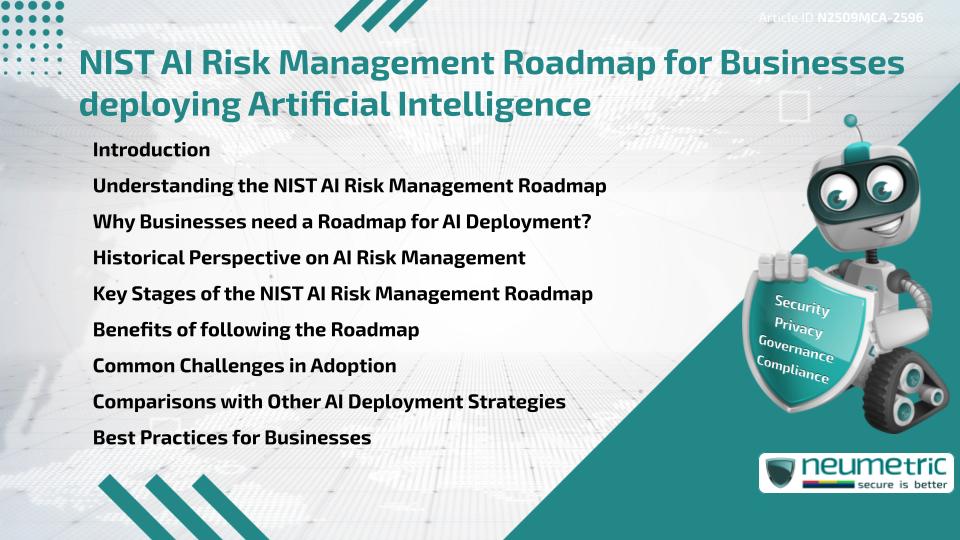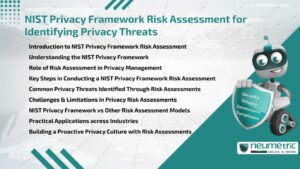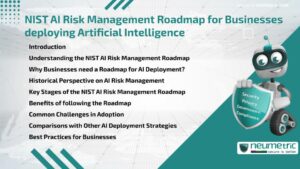Table of Contents
ToggleIntroduction
The NIST AI Risk Management Roadmap provides a structured guide for Businesses deploying Artificial Intelligence [AI], helping them balance Innovation with responsible practices. It outlines the steps required to identify, assess & mitigate Risks while ensuring Transparency, Fairness & Accountability in AI Systems. As AI increasingly influences decision-making in Industries like Healthcare, Finance & Logistics, the NIST AI Risk Management Roadmap serves as a critical resource for aligning AI Deployment with both Operational goals & Ethical Standards.
Understanding the NIST AI Risk Management Roadmap
Developed by the National Institute of Standards & Technology [NIST], the NIST AI Risk Management Roadmap helps Organisations create a systematic approach to AI adoption. It goes beyond Technical safeguards to address societal impacts, Ethical concerns & Regulatory expectations. By following this Roadmap, Businesses can embed Governance, Transparency & Accountability into their AI lifecycle from planning to execution.
Why Businesses need a Roadmap for AI Deployment?
AI Deployment presents both Opportunities & Risks. Without a Roadmap, Businesses Risk facing Operational disruptions, Reputational damage or Regulatory Penalties. The NIST AI Risk Management Roadmap provides clarity by helping Businesses:
- Navigate complex Regulatory landscapes
- Ensure Fairness & reduce Bias
- Enhance Trust among Customers & Partners
- Strengthen resilience against Technical & Ethical failures
Historical Perspective on AI Risk Management
Prior to the Roadmap, Organisations relied on fragmented practices from Cybersecurity, Data Privacy & Enterprise Risk Management. However, AI’s unique challenges, such as Opacity, Bias & Autonomous Decision-making, demanded a dedicated Framework. NIST responded by consolidating lessons from Industry, Academia & Government, creating a Roadmap tailored for AI Deployment.
Key Stages of the NIST AI Risk Management Roadmap
The Roadmap outlines several stages:
- Planning: Identifying objectives, Stakeholders & Risk boundaries.
- Risk Assessment: Evaluating Technical, Ethical & Operational Risks.
- Mitigation: Applying Controls to reduce Risks while maintaining Innovation.
- Monitoring: Continuously Auditing & refining AI Systems.
- Accountability: Assigning responsibilities for outcomes & ensuring Transparency.
These stages ensure that AI Systems evolve responsibly & sustainably throughout their lifecycle.
Benefits of following the Roadmap
Adopting the NIST AI Risk Management Roadmap provides Businesses with:
- Increased Trust from Regulators, Customers & Employees.
- Reduced exposure to Financial, Legal & Reputational Risks.
- Improved Governance & Cross-functional collaboration.
- Alignment with global Ethical AI principles & Regulatory expectations.
Common Challenges in Adoption
Despite its value, Businesses may encounter hurdles:
- Limited Expertise in applying the Roadmap effectively.
- Resource constraints for implementing Governance & Audits.
- Resistance from Teams focused on Speed & Innovation.
These challenges require Leadership commitment & long-term Planning.
Comparisons with Other AI Deployment Strategies
Unlike Ad-hoc AI Deployment strategies, the NIST AI Risk Management Roadmap provides a structured, Risk-focused approach. While general frameworks like ISO 31000 cover broad Organisational Risks, the NIST Roadmap uniquely addresses AI-specific issues such as Algorithmic Fairness & Transparency, making it more practical for AI adoption.
Best Practices for Businesses
To gain the most value from the NIST AI Risk Management Roadmap, Businesses should:
- Form Cross-functional Governance Teams.
- Train Employees on AI Risks & Ethical Standards.
- Conduct regular Audits & reviews of AI Systems.
- Foster open communication with Stakeholders about AI decisions.
By embedding these practices, Businesses can integrate the Roadmap into everyday operations.
Takeaways
The NIST AI Risk Management Roadmap offers Businesses a practical pathway for deploying AI responsibly. While adoption requires effort & resources, the benefits of increased Trust, reduced Risk & sustainable growth make it a vital tool for modern Organisations.
FAQ
What is the NIST AI Risk Management Roadmap?
It is a structured Framework by NIST that helps Businesses deploy AI responsibly by addressing Technical, Ethical & Regulatory Risks.
Why do Businesses need the Roadmap?
It provides clarity in managing AI Risks, ensures Fairness & builds Trust with Stakeholders.
Is the Roadmap applicable across Industries?
Yes, it is designed to be adaptable for Businesses in Healthcare, Finance, Logistics & beyond.
How does it differ from general Risk Frameworks?
Unlike general frameworks, the NIST Roadmap focuses specifically on AI Risks such as Bias, Transparency & Accountability.
Is following the Roadmap mandatory?
No, it is voluntary, but strongly recommended to reduce Risks & align with Regulations.
What challenges exist in adopting the Roadmap?
Businesses may struggle with Costs, Expertise & balancing Innovation with Compliance.
How can Businesses begin implementing the Roadmap?
They can start by defining Governance Teams, conducting Audits & providing training on AI Risks.
Need help for Security, Privacy, Governance & VAPT?
Neumetric provides organisations the necessary help to achieve their Cybersecurity, Compliance, Governance, Privacy, Certifications & Pentesting needs.
Organisations & Businesses, specifically those which provide SaaS & AI Solutions in the Fintech, BFSI & other regulated sectors, usually need a Cybersecurity Partner for meeting & maintaining the ongoing Security & Privacy needs & requirements of their Enterprise Clients & Privacy conscious Customers.
SOC 2, ISO 27001, ISO 42001, NIST, HIPAA, HECVAT, EU GDPR are some of the Frameworks that are served by Fusion – a SaaS, multimodular, multitenant, centralised, automated, Cybersecurity & Compliance Management system.
Neumetric also provides Expert Services for technical security which covers VAPT for Web Applications, APIs, iOS & Android Mobile Apps, Security Testing for AWS & other Cloud Environments & Cloud Infrastructure & other similar scopes.
Reach out to us by Email or filling out the Contact Form…





